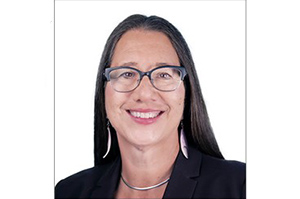- Apply
- Visit
- Request Info
- Give
Mohegan tribe council member discusses the teaching of Native American history
Written by Bobbi Brown
Published on March 10, 2021

Eastern Connecticut State University’s Art Gallery concluded its HEROINE-ITY exhibition on March 4 with a presentation by Elizabeth Regan (“Morning Deer"), vice chair and justice of the Mohegan Council Tribe of Elders. Regan discussed the teaching of Native American history in the education system and justice and activism through her ancestors.
Regan, who studied history, education and human relations at Eastern, began her introduction by speaking in her native language and giving a big “Kutápatômush” or thank you, to the Zoom attendees. She then demonstrated her own personal practice of always thanking her ancestors, “because without them I wouldn’t be here today. It’s my job and my purpose to try and carry their voices forward.”
For her first topic, Regan discussed her dissatisfaction with the teaching of Native American history during her time as a student and how it continues in today’s education system. Tribal crises, violence, war and removal of the Natives have not been well taught to students. Motivated by the teachers that came before her who taught the proper history of Native Americans, Regan was inspired to teach and share the values and experiences of the first people to inhabit what is now the United States.
“Open, honest and inclusive history,” was the idea behind Regan’s new curriculum titled “Native American Studies,” which she created with the help of other Native tribes, Tolland High School and the Mohegan Tribe administration.
Regan displayed a map of Connecticut with 21 red Xs to demonstrate the different Indian trails, villages and sachemdoms that are scattered around the state. “We were here before the states and before the colonies,” said Regan.
Regan also shared some advice and her methods when teaching students. “Go somewhere! Get outside of the classroom.” She believes one of the most effective ways to teach students is to take them out of the traditional classroom setting and visit the places and participate in activities they are learning about. She also shared that she has taken her students to sweat lodges, the Pine Ridge Indian Reservation, the Mohegan Reservation and has even shown them a traditional native ceremony.
“One of my biggest goals is to get more BIPOC people to be educators. To teach Native American studies while being a Native American brings an authenticity to the class that cannot be replicated by a non-native. And I don’t say that in disrespect because we have to have our non-native allies.”
In her segment, “Mohegan Ancestors of Inspiration,” Regan highlighted educator, writer, herbalist and activist Samson Occom (1723–92), who was a member of the Mohegan tribe. Regan shared a story of how she visited his gravesite in New York to show her respects and perform a ceremony. Located on the northern end of Eastern’s campus is a dormitory named after Occom, whose name is also spelled as Occum.
Regan ended her presentation by sharing and dissecting the symbol of The Mohegan Tribe — “Mundo Wigo”—which means “The Creator is Good,” and answering attendees’ questions. “I just want to tell our stories. Every culture has a story. What is your story? Who are you? Embrace it, love it, find your story.”
About the Mohegan Tribal Council:
Located in the southeastern area of Connecticut, the Mohegan Council Tribe of Elders that Beth Regan represents is a seven-member council that oversees judicial matters and cultural integrity while providing information on tribal issues to the state legislature. The council also resolves tribal cultural disputes and enforces tribal customs. To learn more about the Mohegan Tribe along with their history and mission, visit https://www.mohegan.nsn.us/.


